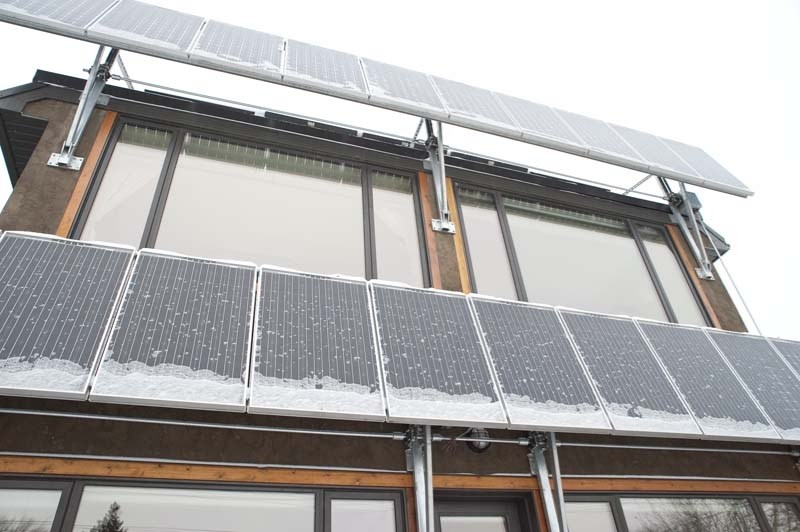Edmonton is now likely the net-zero home capital of Canada, says a local solar energy advocate, and has still more green homes to come.
The Solar Energy Society of Alberta is holding a free talk on the evolution of net-zero home design this Wednesday.
Net-zero homes produce as much energy as they use over the course of a year, reducing greenhouse gas emissions from energy consumption and potentially saving their owners money.
“Edmonton is realistically Canada’s capital for net-zero energy houses,” said society spokesperson Gordon Howell, who helped build the first such home in town in 2007. There are now about 30 homes in the city that are net-zero, with about 20 more that will be net-zero as soon as they get solar panels.
This talk was meant to show how the field has evolved in the seven years since net-zero homes came to town, Howell said. On tap to talk are Peter Amerongen, designer of many of those homes, David Turnbull, whose Landmark Group is using modular construction to mass produce them, and former St. Albert resident Stuart Fix, who is building his own super-efficient home.
One of the biggest lessons builders have learned over the years is to keep it simple, Amerongen said. While their initial designs relied on complex heating systems and insulation to save energy, later models were much simpler and got most of their heat from well-designed windows and walls.
“The third (home we built) is actually producing about twice as much energy as it is using,” Amerongen said.
The cost premium on these homes has also fallen, Amerongen said, dropping to about $50,000 extra today from $110,000 in 2007.
“A big chunk of that is the declining cost of photovoltaics,” he said, which have dropped rapidly in recent years.
The talk starts at 7 p.m. this Jan. 22 at MacEwan University in Room 5-142. Visit solaralberta.ca for details.
Albertans could save up to $1.5 billion a year and slash their greenhouse gas emissions if the province invests in energy conservation, says a new report.
The Alberta Energy Efficiency Alliance released a report this week that looks at how Alberta could save money and prevent climate change through energy conservation. The alliance includes groups such as Suncor, Cenovus, the cities of Edmonton and Calgary, and the Pembina Institute.
The report looked at all the energy efficiency opportunities in Alberta that are currently affordable and determined their effects on costs and emissions, said Jesse Row, executive director of the alliance.
The report found that Alberta could save a net $1.45 billion in energy costs and prevent about 26.7 megatonnes of emissions a year by 2020 if it took all those opportunities – enough to get it halfway to its 2020 emissions reduction target.
“There are efficiency opportunities in pretty much every building and industrial facility out there,” Row said, including better insulation, efficient heating systems and fewer leaky pipes.
Some of the biggest proportionate reductions are in the residential sector. Homeowners could knock a quarter off the heating bills of an old home through efficiency measures, the report found, and about 60 per cent off the heating bills of a new one.
Today’s buyers aren’t trained to think about energy efficiency, said Leigh Bond of St. Albert’s Threshold Energies Corp., so they don’t ask about it, and builders don’t provide it. The result is poorly insulated buildings with vast room for improvement.
Conservation is the most cost-effective way to reduce greenhouse gas emissions, Row said, with U.S. programs getting two to three dollars back for every dollar put in.
The alliance wants the province to take about a third of the Climate Change and Emissions Management Fund (or about $20 million) each year and use it to fund energy efficiency programs to spur conservation.
That fund, now worth about $380 million (and growing at about $65 million a year), collects a $15-a-tonne carbon levy from companies that fail to meet their annual emission reduction targets, reports the Climate Change and Emissions Management Corporation (the group which manages it). The fund is currently designed to fund big industrial projects like Edmonton’s waste-to-energy facility, and would have to be changed to support conservation programs.
Alberta is the only province with this kind of fund, Row said, giving it a unique opportunity to support conservation programs without using tax dollars.
Bond supported the idea of putting some of the fund’s cash towards conservation programs, specifically energy efficiency education, as that would drive demand for more efficient homes.
“They’re teaching kids about energy in school now in Grade 6 … but old people like me need to be educated too.”
The report is available at www.aeea.ca.




